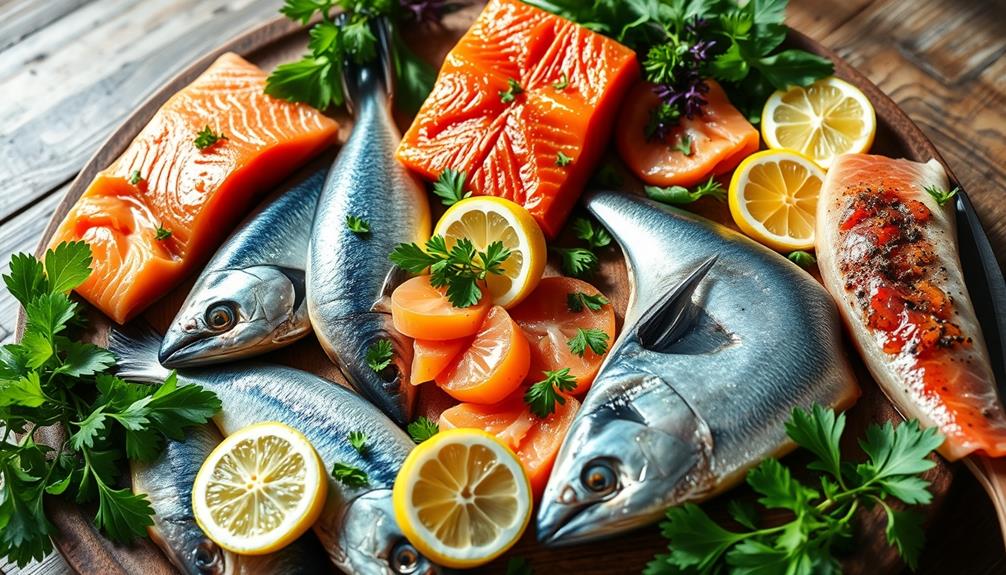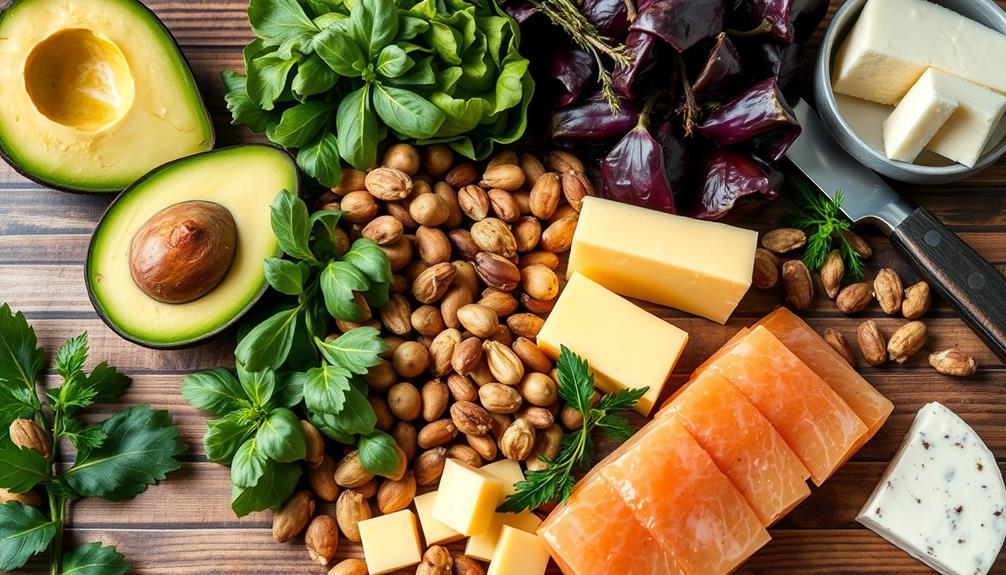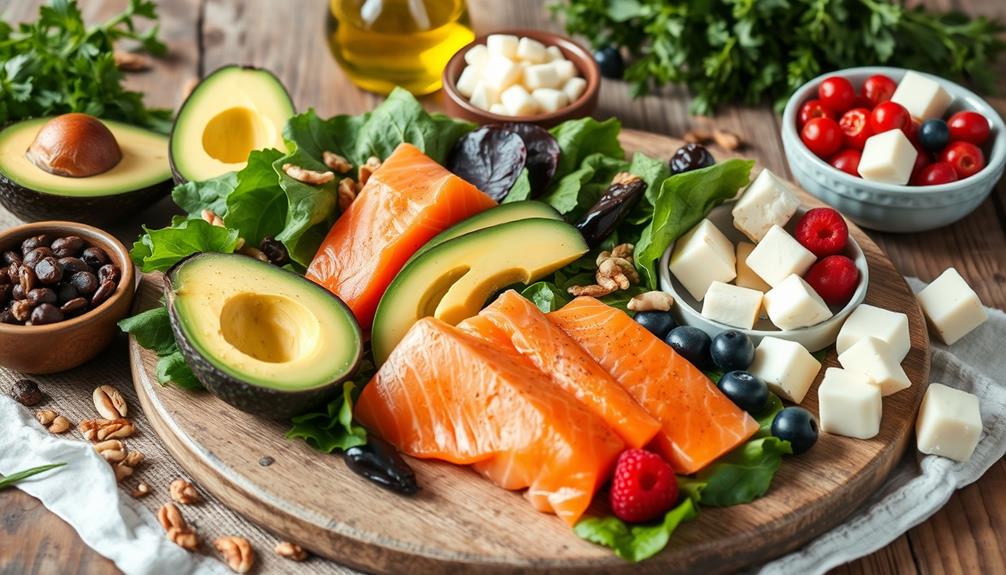The best fish to eat on a keto diet includes fatty options that support your nutritional needs. Wild salmon and mackerel are top choices, packed with omega-3 fatty acids, protein, and healthy fats. Sardines and anchovies also offer high protein content while being low in carbs. Fresh tuna's lean profile makes it a solid option too. To maximize benefits, cook them using healthy methods like grilling or baking. These fish not only keep you in ketosis but also enhance your overall well-being. Keep exploring to discover tasty recipes and tips for incorporating these fish into your meals! You can also incorporate ketofriendly meat options like grass-fed beef, pasture-raised pork, and free-range chicken into your keto diet. These meats provide essential nutrients and are low in carbs, making them a great addition to your meal plan. Experiment with different cooking techniques and seasonings to keep your keto meals interesting and satisfying.
Key Takeaways
- Fatty fish like wild salmon and mackerel provide high omega-3s and healthy fats, essential for a keto diet.
- Anchovies and sardines are protein-rich, delivering 28g and 22g of protein per 100g, respectively.
- Fresh tuna offers a lean option with 27.5g of protein and minimal fat, suitable for keto when paired with healthy fats.
- Aim for fish high in vitamins D and B12, contributing to overall health and supporting keto nutritional needs.
- Choose sustainably sourced fish like Atlantic mackerel and wild King salmon for both health benefits and environmental responsibility.
Understanding the Keto Diet

When you immerse yourself in the ketogenic diet, you'll find it's all about drastically reducing your carbohydrate intake while increasing your fat consumption. The keto diet is great for those looking to shed pounds and boost energy levels.
By limiting carbs to just 5-10% of your daily calories and ramping up healthy fats to 70-80%, your body enters ketosis, a state where it efficiently burns fat for energy instead of carbs. This shift can also lead to benefits like improved mental clarity and reduced inflammation, similar to the effects of consuming celery juice, known for its anti-inflammatory properties.
This dietary shift not only aids in weight loss but also curbs hunger and cravings. You'll discover that fatty fish, among other sources of protein, plays a crucial role in your meal plans.
Fish like salmon and mackerel are particularly beneficial due to their high omega-3 fatty acids content, which supports heart health and enhances overall well-being.
Incorporating fatty fish into your ketogenic diet offers a delicious way to meet your protein needs while enjoying healthy fats.
Just remember to consult with healthcare professionals before diving into this lifestyle to verify it suits your individual health goals. Embrace the journey, and you'll soon appreciate the many advantages of this low-carbohydrate approach.
Nutritional Benefits of Fish
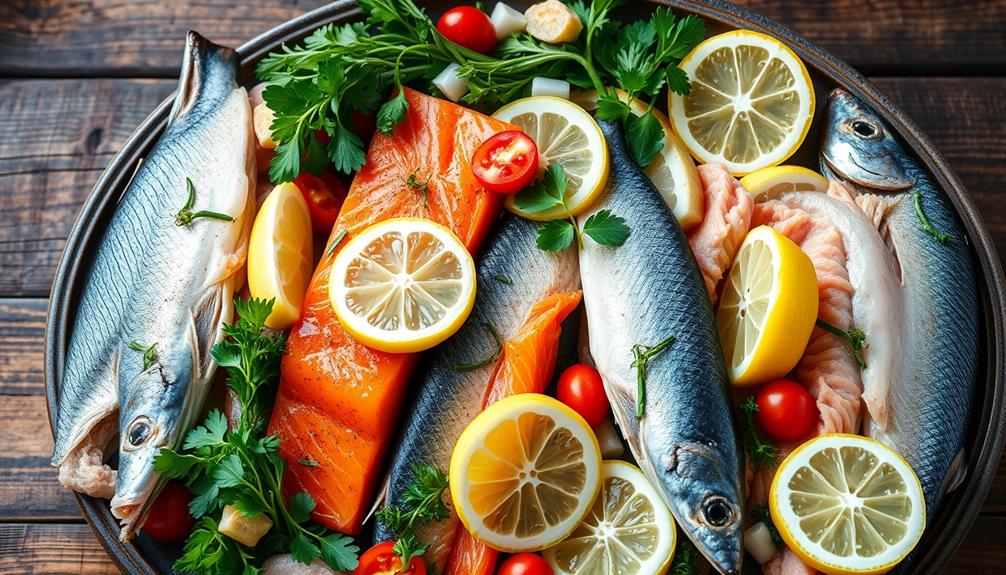
When you include fish in your keto diet, you're tapping into a rich source of omega-3 fatty acids that promote heart health and reduce inflammation.
Additionally, fish is low in carbohydrates, making it an ideal choice for maintaining ketosis. Not only is fish packed with protein, but it also delivers essential vitamins and minerals that support your overall well-being.
By choosing fatty fish, you're ensuring you get the nutrients you need while keeping your carb intake low.
For more detailed guidance on dietary choices, you may find information on cold medications overview helpful.
Omega-3 Fatty Acids Benefits
Omega-3 fatty acids are essential for your health, especially when it comes to heart wellness and inflammation management. Found abundantly in fatty fish like salmon and mackerel, these nutrients considerably contribute to heart health by reducing the risk of heart disease and stroke.
For instance, a 3-ounce serving of mackerel packs about 2,990 mg of omega-3 fatty acids, easily surpassing the recommended daily intake of 250-500 mg. Additionally, certain essential oils like eucalyptus oil can support overall health, complementing the benefits of omega-3-rich fish.
Regularly including omega-3-rich fish in your diet not only supports heart health but also boosts your cognitive function. Studies suggest that such consumption can improve your mood and lower the risk of depression and cognitive decline.
Additionally, omega-3 fatty acids play a vital role in reducing inflammation throughout your body, which helps manage chronic diseases and enhances overall health.
When you follow a ketogenic diet, incorporating fish high in omega-3s promotes a healthy balance of fatty acids. This is particularly beneficial compared to diets that are higher in omega-6 fatty acids, which can lead to inflammation.
Protein-Rich Options
Fish is a fantastic source of high-quality protein, making it an ideal choice for those on a keto diet. Incorporating seafood into your meals not only boosts your protein intake but also keeps your carb count low, which is crucial for maintaining ketosis.
Here's a quick look at some protein-rich fish options:
| Fish Type | Protein (per 100g) |
|---|---|
| Anchovies | 28g |
| Fresh Tuna | 27.5g |
| Wild Salmon | 20g |
| Mackerel | 20g |
Oily fish like mackerel and sardines are particularly beneficial, as they provide protein along with omega-3 fatty acids, which are essential for heart health. Fresh tuna is another excellent choice, yielding nearly 28g of protein while remaining low in carbs. Wild salmon also complements your protein needs effectively.
Essential Vitamins and Minerals
In addition to being a great source of protein, fish offers a wealth of vitamins and minerals that support overall health. When you include fish in your healthy keto diet, you benefit from essential nutrients that help prevent heart disease and boost your immune system. Oily fish, like mackerel and sardines, are excellent sources of vitamin D, with Atlantic mackerel providing 91% of the RDA per 100g.
Moreover, incorporating fish into your meals can be part of a well-rounded financial strategy—considering the potential long-term savings on healthcare costs from maintaining good health, as highlighted in the financial mistakes to avoid.
Fish is also rich in B vitamins, particularly B12, important for nerve function and red blood cell production. Wild salmon delivers over 300% of the RDA for B12 per 100g, making it a powerhouse for energy metabolism. In addition, fish provides significant amounts of niacin (B3), which supports skin health.
Don't forget about omega-3 fats! These essential fatty acids, abundant in fatty fish, play a key role in heart health and reducing inflammation. For instance, wild salmon contains around 4,123 mg of omega-3s in half a fillet.
Top Fish Choices for Keto

When you're following a keto diet, choosing the right types of fish can greatly boost your meal plans. Here are some of the top fish choices that are not only keto-friendly but also packed with nutrients to support your health.
| Fish Type | Protein (g/100g) | Fat (g/100g) |
|---|---|---|
| Wild Salmon | 21 | 4.4 |
| Atlantic Mackerel | 16.2 | 20.3 |
| Sardines | 22 | 11.5 |
| Anchovies | 28 | 15.9 |
| Fresh Tuna | 23 | 1.5 |
Wild salmon is a fantastic choice, rich in omega-3 fatty acids and protein. Atlantic mackerel is another excellent option, offering a high fat content along with vitamin D. Sardines are both tasty and nutritious, delivering crucial B vitamins. Anchovies are versatile, providing a punch of protein and healthy fats. Finally, fresh tuna is a lean source of protein, ideal for various dishes. Incorporating these keto-friendly fish into your diet can help you enjoy your meals while staying on track with your keto goals.
Cooking Methods for Fish

Cooking fish can be a delightful experience that brings out its natural flavors while keeping your meals healthy. Various cooking methods can enhance different types of fish, making it easier for you to enjoy a keto-friendly diet rich in omega-3 fatty acids.
For instance, ensuring proper airflow while cooking can also help maintain the quality of your fish, much like how regular maintenance improves air purifier efficiency.
Grilling is a fantastic choice, especially for fatty fish like salmon and mackerel. It enhances their flavors while maintaining a healthy approach.
If you prefer a method that retains moisture and nutrients, baking is ideal for delicate varieties like cod and tilapia.
For a quick and tasty option, you can pan-fry fish in healthy oils such as olive or coconut oil, which adds even more healthy fats to your meal.
Poaching is another gentle technique that preserves the tenderness of leaner fish like halibut and flounder, offering a subtle flavor.
Nutritional Profiles of Fish
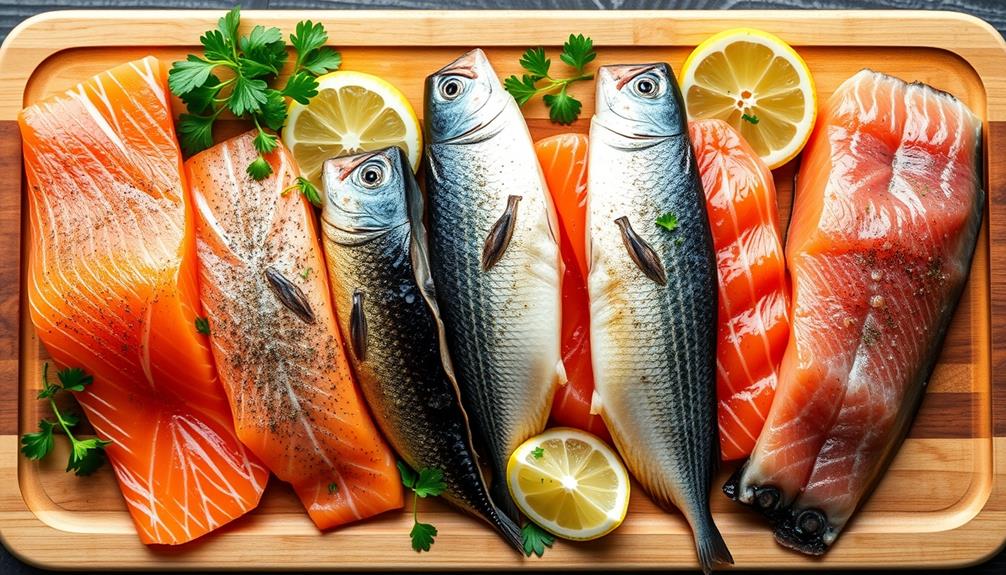
Choosing the right fish for your keto diet not only enhances your meals but also boosts your nutritional intake. Fish is a fantastic source of healthy omega-3 fatty acids and protein, making it one of the best fish for keto. Below is a quick comparison of some popular options:
| Fish | Fat (g) | Protein (g) | Calories |
|---|---|---|---|
| Atlantic Mackerel | 20.3 | 16.2 | 290 |
| Farmed Arctic Char | 11 | 16 | 208 |
| Anchovies | 15.9 | 28 | 256 |
| Farmed Salmon | 11 | 17 | 234 |
| Wild King Salmon | 12 | 20 | 195 |
Each of these options is high in protein and offers a mild flavor that pairs well with various keto-friendly ingredients. Incorporating these types of fish into your meals not only provides essential nutrients but also supports your overall health benefits on a ketogenic diet. So, immerse yourself in these keto-friendly seafood choices to meet your dietary goals while enjoying delicious meals!
Health Benefits of Fatty Fish
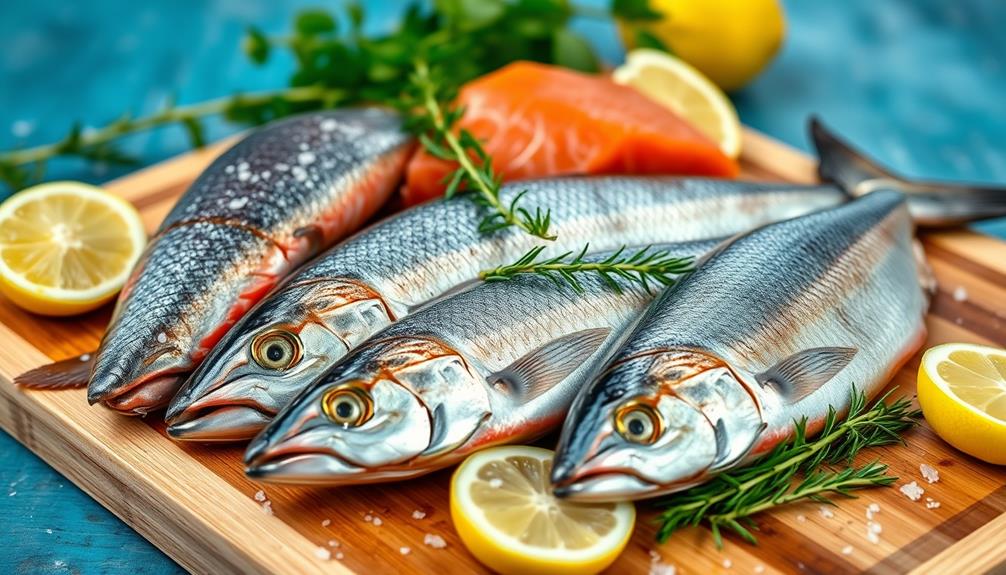
Fatty fish like salmon and mackerel are nutritional powerhouses packed with health benefits. These fish are rich in omega-3 fatty acids, which are essential for reducing inflammation and promoting heart health. By incorporating fatty fish into your diet, you're not just enjoying a delicious meal, but also supporting your overall health.
In addition, understanding the differences between types of fish can enhance your dietary choices and cooking techniques, especially when considering their unique flavor profiles and health benefits. Regularly enjoying various fish can also create a unique aroma in your kitchen, akin to burning coffee beans for an inviting atmosphere.
One of the standout benefits of fatty fish is its high nutrient density. Regular consumption is linked to a lower risk of chronic diseases, including heart disease and stroke. Plus, these fish provide essential fat-soluble vitamins like vitamin D and vitamin A, which are important for immune function and bone health.
Don't overlook the significance of selenium, an antioxidant found in fatty fish that supports thyroid function and protects your cells from oxidative stress. Additionally, studies suggest that eating fatty fish can improve mood and sleep patterns, likely due to their omega-3 fatty acid content.
Incorporating fatty fish into your keto diet not only enhances flavor but also offers a myriad of health benefits that contribute to your long-term well-being. So, immerse yourself in a plate of these nutritious options and enjoy the advantages they bring!
Dietary Considerations for Fish
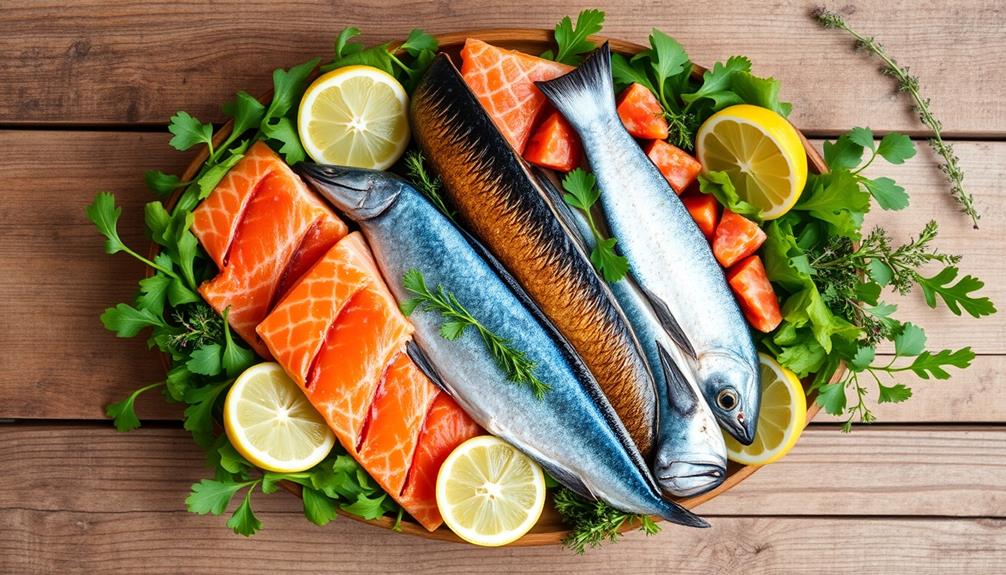
When it comes to incorporating fish into your keto diet, considering the type and preparation method makes a big difference. Fish can be an excellent source of protein while keeping your carb intake low, essential for maintaining ketosis.
To maximize your health benefits, pay attention to fat content and choose wisely, just as you'd with energy-efficient systems like the ultimate heat pump.
Here are some dietary considerations for including fish in your keto meal plan:
- Fatty fish like salmon and mackerel are rich in omega-3 fatty acids, which help reduce inflammation and support heart health.
- Lean fish such as cod and flounder are lower in fat, so you'll want to add healthy fats during preparation to meet your keto diet goals.
- Regularly incorporating fish provides significant nutrients like vitamin D, B vitamins, and selenium, which are essential for overall health.
Aim for a macronutrient distribution of 70-80% fat, 15-30% protein, and minimal carbohydrates (0-10%).
This way, you can enjoy the myriad health benefits while sticking to your keto diet. Remember, the right fish choices can enhance your meals and keep your body nourished!
Delicious Keto Fish Recipes

If you're looking to spice up your keto meal plan, delicious fish recipes can be a game-changer. Incorporating keto fish into your diet not only satisfies your taste buds but also provides essential omega-3 fatty acids and healthy fats. Here are some fantastic seafood options to take into account:
| Recipe | Main Ingredients | Benefits |
|---|---|---|
| Keto Garlic Butter Salmon | Salmon fillets, butter, garlic | Low-carb meal rich in omega-3s |
| Keto Fish Cakes with Herb Salad | Salmon fillets, almond flour, eggs | Flavorful, protein-packed |
| Air Fryer Keto Salmon | Salmon fillets | Crispy, easy weeknight dinner |
These recipes are not only easy to prepare but also guarantee you're sticking to your low-carb meal goals. For example, Keto Shrimp Scampi features shrimp sautéed in butter and garlic, making it a rich family favorite. Baked Mackerel with Herbs is another nutritious meal that's high in healthy fats and perfect for the ketogenic diet. By trying out these delicious keto fish recipes, you can enjoy a variety of flavors while staying on track with your keto lifestyle.
Sustainable Seafood Options

Choosing sustainable seafood options is essential for both your health and the environment. By selecting fish that are sourced responsibly, you can enjoy delicious meals while supporting marine conservation efforts.
Additionally, understanding the impact of your food choices on overall health and wellness is vital; for example, including omega-3-rich fish can play a significant role in financial considerations for elderly care as it promotes better health outcomes in older adults.
Look for the Marine Stewardship Council (MSC) certification when purchasing seafood, as this label guarantees that the fish come from well-managed fisheries.
Here are some sustainable seafood options to take into account:
- Farmed Arctic Char: A delicious alternative that's raised using responsible aquaculture practices.
- Wild King Salmon: Known for its rich flavor and high omega-3 content, this fish is a healthy choice.
- Atlantic Mackerel and Sardines: These smaller fish aren't only nutrient-dense but also help to reduce overfishing concerns.
Frequently Asked Questions
What Is the Best Fish for Keto?
When considering the best fish for your diet, think about options like salmon and mackerel. They're packed with healthy fats and omega-3s, making them perfect for boosting your nutrition while keeping carbs low.
Which Fish Is Lowest in Carbs?
You might think all fish have carbs, but that's not true! Cod, flounder, and shrimp are some of the lowest-carb options you can enjoy. They'll keep your meals delicious while maintaining your keto goals.
Can You Eat Fish Everyday on Keto?
Yes, you can eat fish every day on keto. It's low in carbs and packed with protein and healthy fats. Just mix up the types to guarantee a balanced nutrient intake and avoid heavy metal exposure.
What Meat Is Best for Ketosis?
For ketosis, you'll want to focus on fatty cuts of beef, pork belly, and organ meats. Poultry with skin, like chicken thighs, works too. Just avoid processed meats with added sugars that spike carbs.
Conclusion
Incorporating fish into your keto diet not only tantalizes your taste buds but also fuels your body with essential nutrients. By choosing fatty fish and experimenting with various cooking methods, you'll discover a world of flavors while reaping the health benefits. Remember, the ocean's bounty is vast; make sustainable choices to protect our waters. So plunge in, savor the delicious recipes, and let the sea nourish your keto journey. After all, good health is the catch of the day!
